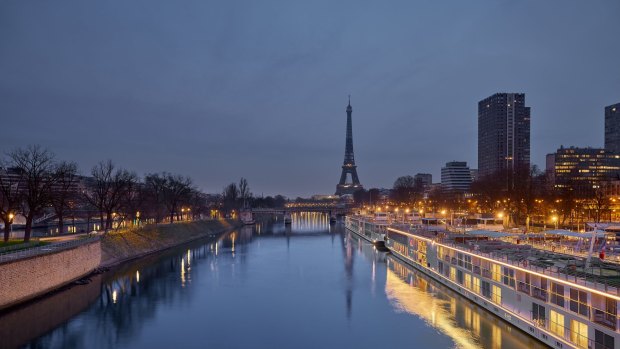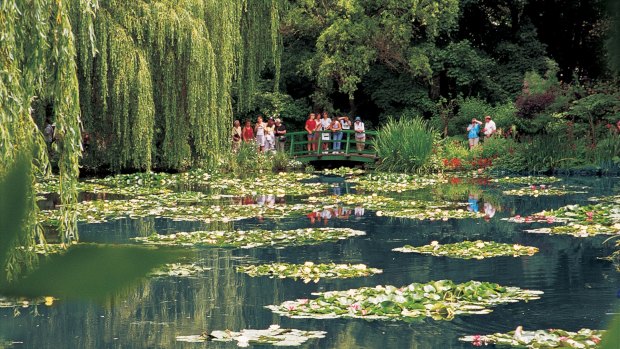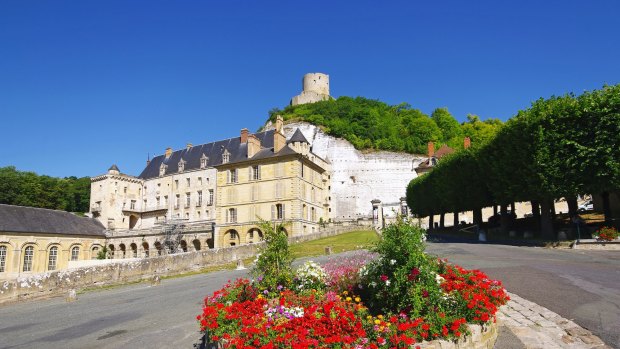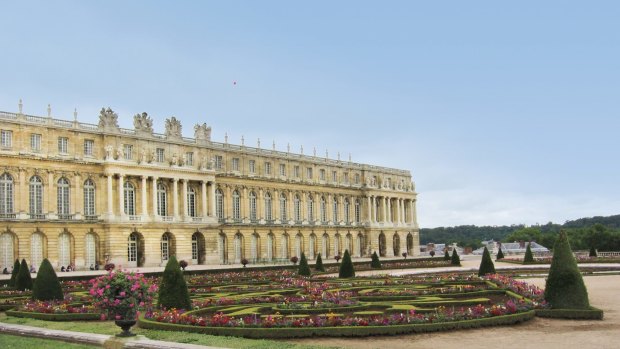This was published 1 year ago
Viking Radgrid: A brush with Monet's France while cruising the River Seine
By Jane Knight

Cruising in comfort along the River Seine on the newly-launched Viking Radgrid.Credit: Adam Hillier
It's a brush with art we aren't expecting. As we cycle along the country bike route to Giverny, the Normandy village Claude Monet painted onto the art map, our guide stops to tell us: "This is actually the old railway line where Monet glanced out of the window on the train from Paris and discovered Giverny."
The father of impressionism fell in love with the place, living there for 43 years after his arrival in 1883, and as we pedal along, calling out the occasional "bonjour" to the dog-walking residents, I can see why. This little village of about 500 inhabitants is all creeper-clad stone houses with shutters and pretty gardens.
The most spectacular garden of all, of course, is Monet's, with its Japanese bridge and water lilies he immortalised on canvas. Here, on the Rue Claude Monet, is his salmon-pink house with green shutters. Here too is the Museum of Impressionism, where we drink in the watery landscapes that obsessed him. Just along the street is the Ancien Hotel Baudy, once a weekend haven for everyone from Renoir and Rodin to Cezanne and Sisley when they visited from Paris.

Monet's garden, with its Japanese bridge and water lilies, which he immortalised on canvas.
We have also arrived from Paris, but only the last six kilometres were in the saddle; instead we are cruising in comfort along the River Seine on the newly-launched Viking Radgrid. With her hybrid engines and onboard battery pack, she offers a beautifully smooth sail, which means that as we sit at the rounded bow of the boat, watching herons flit by and admiring riverside gardens, the only rock we feel is from our rocking chairs.
It is Radgrid's base in Paris that really impresses, though. One of four new Seine-class ships, she qualifies to dock at the central Port de Grenelle by virtue of being 10 metres smaller than Viking's normal 135-metre longships. Talk about a mooring offering more: this one comes with a front-row view of the Eiffel Tower. On checking in, I'm delighted to find I can see the famous tower dazzling in daytime and sparkling with lights at night from the balcony of my Scandi-chic suite, with its compact bathroom.
Despite the shortened size, the 168-berth Radgrid is almost identical to Viking's longer ships, with the Aquavit Terrace at the bow a popular place for an informal meal, the sun deck on the top with its comfortable seats the perfect place to take in the views.

Catch the dazzling lit-up Eiffel Tower at night from the balcony of your Scandi-chic suite.
She certainly makes a stylish base from which to explore the City of Light, which is full of impressionist art. The Musee d'Orsay houses a huge collection, with more of Monet's paintings on show in the Orangerie in the Tuileries, while at the Musee Marmottan Monet, you can see the painting which gave the movement its name: Impression: Soleil Levant.
All too soon, it's time to slip out of Paris, sailing slowly back through the centuries along France's main river artery on a return voyage to Rouen and the Normandy coast to a world where it's easy to imagine the impressionists setting up an easel in the bucolic fields we pass.
They did just that at our first stop, La Roche-Guyon, which features in many of their works. And no wonder — it's pretty as a picture, a medieval castle tower standing guard over a loop in the river while a more elegant 18th-century chateau clings to the chalkface below.

Viking Radgrid takes you away from the main flow of tourists, to places like La Roche-Guyon.Credit: Shutterstock
"It's mostly Parisians who visit here," our guide Ariane tells us of this sleepy village of 473 with its colourful shuttered and half-timbered buildings as well as former troglodyte dwellings.
"The docks were only built a few years ago."
That's one of the beauties of this river cruise; as well as taking in big-hitter sites such as Giverny and Versailles, it also takes you away from the main flow of tourists, to places you might otherwise never have discovered.

Versailles is a highlight for many of us on this cruise.
It's from the top of the 12th century tower, reached via a secret staircase with 270 steps cut into the hillside, that I can really appreciate the strategic importance of La Roche-Guyon. This aerie was an important defence for medieval France, with the English-owned dukedom of Normandy right on its doorstep. It was important in World War II as well; German field marshal Rommel set up his headquarters to protect the Atlantic Wall here, with bunkers carved out in the cliffs below for ammunition stores and a thick shrapnel-proof concrete wall added at the entrance.
Somewhat ironically, he held his meetings in a room draped with enormous tapestries telling the story of Esther, the Jewish heroine. It's just one of the opulent rooms that the 18th-century Duke de La Rochefoucauld added to the chateau, along with painted timber ceilings, Rococo designs, and oak parquet flooring copied from Versailles. Even the stables look like a mini chateau, with huge windows and an outdoors horse bath, while high on the hillside, three chapels are carved into the rockface.
Back on board Viking Radgrid, it's somehow lunchtime already, even though it seems that only moments ago we were munching on treats from the local bakery at the start of our excursion. Food is a big feature on this cruise, and with dishes such as goats cheese souffle, mussels, chateaubriand and creme brulee, there's no mistaking that we're in France.
Our shore excursions always include a tasty morsel or two - our cycle trip to Giverny is rewarded with an impromptu picnic of macaroons and local cider, while back on board there are cookery demonstrations if you want to learn how to whip up a tarte au citron back at home. Evenings bring cognac and cheese tastings if you haven't eaten enough at the three-course meal with complimentary drinks.
Luckily, there are plenty of places to work off the calories along the length of the voyage: I ignore the lift and climb the steel innards of the Eiffel Tower in Paris, cycle the 12-kilometre round trip from Vernon with its medieval half-timbered bridge to Giverny and back, and puff my way to the very top of the tower at La Roche-Guyon.
I get more steps in by exploring some of the vast grounds at Versailles, the highlight for many of us on this cruise.
First, though, there's the obligatory stop for breakfast at the Ore Ducasse cafe, where Marie Antoinette might be disappointed to hear that there is no cake on the menu, although there are plenty of croissants and pains au chocolats.
Stomachs satisfied, we feast our eyes on the realm of the Sun King, Louis XIV, where the newly-regilded chapel sparkles along with the rest of the golden exteriors. Within lies a world of opulence: ceilings drip with chandeliers, and one lavishly furnished apartment leads to another. Louis's image is everywhere: a statue portrays him as a Roman Emperor, a cuckoo clock has angels crowning a figurine of the king, and a painting in the audience chamber shows him flaunting one of his 400 wigs.
All that, though, is just a warm up for the Hall of Mirrors, which glimmers even in the morning light. At sunset, with candles lit, it is apparently even more beautiful, with its 357 mirrors twinkling in the sun's last breath.
Small wonder that more than a century later, the French protested at so much ostentatious wealth, marching on Versailles during the 1789 French Revolution, which prompted its furniture to be auctioned and its paintings moved.
Fast forward to modern times and it was the French art expert Gerald Van der Kemp who was instrumental in returning Versailles to its glorious heyday, searching for lost treasures and recreating the palace's splendours with an army of plasterers, silversmiths and gilders.
It was Van der Kemp, too, who helped restore Monet's run-down house and garden in Giverny before it re-opened in 1980. An accomplished gardener and painter, he died in 2001.
You can find his grave back at Giverny, outside the Romanesque church of St Radegonde, touchingly planted with flowers from Monet's garden. Nearby lies the artist's own flower-adorned family tomb, where hyacinths, not water-lilies, bloom.
FLY
Several airlines fly to Paris from Australian cities, including Emirates, Qantas and Etihad.
See emirates.com; qantas.com; etihad.com
STAY
If you stay overnight in Paris before or after your cruise, the rooms at Madame Reve have the feel of a cruise ship about them, with low ceilings and sloping glass windows framing the city skyline. Converted from a former 24-hour post office, the hotel also has an impressive roof terrace. Rooms from $874 a night. See madamereve.com.
TOUR
An eight-day Paris and the Heart of Normandy cruise from Paris to Rouen and back to Paris costs from $3495 a person in a standard stateroom or from $7695 a person in an Explorer Suite. Drinks are included at lunch and dinner. The price includes savings of up to $1000 a couple and $1000 flight credit a couple when booked by 31 May 2022. See vikingrivercruises.com.
Jane Knight travelled as a guest of Viking Cruises and Madame Reve.
Sign up for the Traveller Deals newsletter
Get exclusive travel deals delivered straight to your inbox. Sign up now.